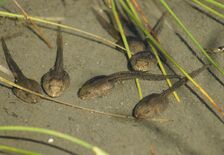CONSERVATION CORNER
A weekly blog for all things conservation
 By: Jonathan VanNoy, Natural Resource Specialist This is a question that we at the Conservation District hear with various wording on a fairly consistent basis, but especially after flooding events. The statement is exaggerated to make a point, but the emotion that I hear behind it is sincere. “WHY am I not allowed to protect my property!?’ So, why does DEP (as well as the Army Corps of Engineers) restrict us from doing much work in our streams? Let’s take a look at the PA Code, Title 25 (Environmental Protection), Chapter 105. Chapter 105 regulates Dam Safety and Waterway Management. Chapter 105 starts out with some definitions, and then moves on to why this legislation was created. Here is language taken directly from Chapter 105:
§ 105.2. Purposes. The purposes of this chapter are to: (1) Provide for the comprehensive regulation and supervision of dams, reservoirs, water obstructions and encroachments (work done in the streams) in the Commonwealth in order to protect the health, safety, welfare and property of the people. There are several other items listed in the “Purposes” section of Chapter 105; eventually naming environmental protection, but I find it interesting that priority #1 is about protecting people! So again, how would stopping a land owner or municipality from “cleaning the stream” protect people? After a flood event, people typically think that dredging the stream channels, or building flood walls on the steam banks will solve their stream related problems. Seems logical, right? So, why can’t we do it? Unfortunately, the idea of dredging a channel out often carries unforeseen consequences. A channel that is deepened even in one small section becomes unstable. Stream bed material upstream of the excavated section are swept into the new void space that has been created in the stream bed. This erosion of the stream bed, called a headcut, will carry upstream until the bed slope is equalized. This could go for hundreds of yards or much more, depending on the bed slope and extent of material excavated. As the headcut works upstream, the channel deepens, and the upstream banks (now essentially at a steeper angle due to increased height as the stream bed drops out below them) become unstable and collapse. The new sediment and rock will overwhelm the capacity of the stream to carry it all and be deposited as gravel or sand bars in the immediate area of erosion, or be carried untold distances downstream until the velocity slows enough that they drop out. Neighbors upstream of the dredging are affected by the erosion and unstable banks, as well as people far downstream from the deposition of bed and bank material. Additionally, the small (and temporary!) increase in channel capacity gained from dredging makes almost zero difference in flood stage elevations. The water volume is simply overwhelming during a flood! Similarly, berming up the stream banks causes increased erosive force inside the stream channel. All that area that the water used to have to spread out on the land around the stream (floodplain) is cut off, forcing the water into a more confined space. The water velocity in the stream channel, and subsequently erosive force, is increased. Often, all that loose material excavated from the stream and piled up gets eroded right back into the channel during the next high-water event. Remember that increase in erosive force? Also, if one bank has a high berm built up on it, there is increased potential to flood out the land/people on the opposite side of the stream! The laws that are in place regulating stream work are there because it has been demonstrated time and time again that these ideas of “fixing” steams with dredging and berms/dikes do not work in the long term and are in fact detrimental to people and properties along our streams. With all that being said, there certainly are times when stream channels DO need excess materials removed from them. In these cases, DEP (and your local Conservation District!) are here to help with the permitting process. Next week we will look at some of the options available if you need to do work in the streams. *Trying to visualize the side effects of dredging can be difficult. Try doing a youtube search for “stream behavior: dredging deeper channel behavior”. The video is a Cornell University production and does a great job of illustrating effects of dredging. The Bradford County Conservation District is committed to helping people manage resources wisely. You can visit the Bradford County Conservation District at 200 Lake Rd in Wysox across from the Wysox Fire Hall. Contact us at (570) 485-3144 or visit our web page at www.bccdpa.com.
0 Comments
Leave a Reply. |
AuthorsVarious staff at the Bradford County Conservation District Archives
April 2024
Categories
All
|
